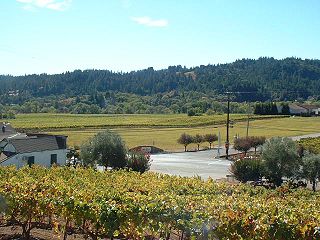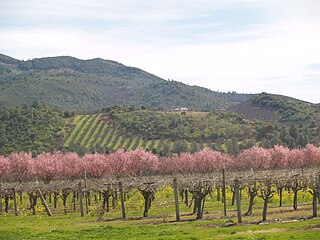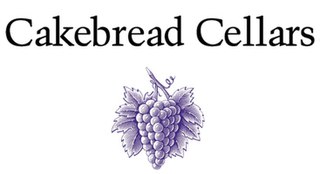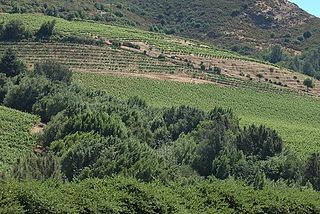
Livermore Valley is an American Viticultural Area (AVA) in Alameda County, California, centered around the city of Livermore in the Tri-Valley region which is composed of Amador, San Ramon, and Livermore valleys. The valley was named by Robert Livermore, an 18th century landowner whose holdings encompassed the area who planted the first grapevines in the region. The 96,000 acres (150 sq mi) AVA was established on September 1, 1982 by the Bureau of Alcohol, Tobacco and Firearms (ATF), Treasury after reviewing the petition submitted by fifteen Livermore Valley vintners and growers to establish a viticultural area in Alameda County named "Livermore Valley."

Arroyo Seco is an American Viticultural Area (AVA) in Monterey County, California, southeast of Monterey Bay. The state's 15th appellation was established on May 16,1983 by the Bureau of Alcohol, Tobacco and Firearms (ATF), Treasury after reviewing the petition submitted by the Arroyo Seco Winegrowers and Vintners, an association composed of grape growers and vintners with vineyards, to establish a viticultural area within Monterey County known as "Arroyo Seco."

Washington wine is a wine produced from grape varieties grown in the U.S. state of Washington. Washington ranks second in the United States in the production of wine. By 2017, the state had over 55,000 acres (220 km2) of vineyards, a harvest of 229,000 short tons (208,000 t) of grapes, and exports going to over 40 countries around the world from the 940+ wineries located in the state. While there are some viticultural activities in the cooler, wetter western half of the state, the majority (99.9%) of wine grape production takes place in the shrub-steppe eastern half. The rain shadow of the Cascade Range leaves the Columbia River Basin with around 8 inches (200 mm) of annual rain fall, making irrigation and water rights of paramount interest to the Washington wine industry. Viticulture in the state is also influenced by long sunlight hours and consistent temperatures.

Red Mountain is an American Viticultural Area (AVA) that encompasses the local region surrounding Red Mountain in Benton County, Washington. The viticultural area was formally recognized on June 11, 2001 by the Bureau of Alcohol, Tobacco and Firearms (ATF), Treasury after reviewing the petition submitted by Lorne Jacobson of Hedges Cellars to establish an area known as "Red Mountain." It lies entirely within the Yakima Valley and vast Columbia Valley appellations and is a small AVA in the state at only 4,040 acres (6.31 sq mi) in area and lies between Benton City and the City of West Richland. The area has more than 2,225 acres (900 ha) under cultivation of primarily red varietals including Cabernet Sauvignon, Merlot, Sangiovese, Cabernet Franc and Syrah. The reputation of the area's wines has brought Red Mountain worldwide attention and acclaim for producing some of the most desired Washington State vintage wines.

Napa Valley is an American Viticultural Area (AVA) in Napa County, California. The area was established by the Bureau of Alcohol, Tobacco, Firearms and Explosives (ATF) on February 27, 1981 after reviewing the 1978 petition submitted by the Napa Valley Vintners and Napa Valley Grape Growers Association on behalf of valley vineyard owners and winemakers proposing to establish a viticultural area named "Napa Valley" as an appellation of origin in wine labeling and advertising would help consumers of wine to better identify Napa Valley wines. Napa Valley is considered one of the premier wine regions in the world.

Sonoma County wine is wine made in Sonoma County, California, in the United States.

St. Helena is an American Viticultural Area (AVA) located within Napa Valley, centered in and around the town of St. Helena, California. It was established by the Bureau of Alcohol, Tobacco and Firearms (ATF) on October 11, 1995, after the ATF received a petition from Mr. Charles A. Carpy, Chairman of the St. Helena Appellation Committee, proposing to establish a new viticultural area in Napa County to be known as "St. Helena."
The Chiles Valley is an American Viticultural Area (AVA) located in Napa County, California and a sub-region within Napa Valley AVA. It was established as California's 81st AVA by the Bureau of Alcohol, Tobacco and Firearms (ATF) on April 19, 1999 after the ATF received the petition from Mr. Volker Eisele, owner of the Volker Eisele Vineyard and Winery proposing a new viticultural area in Napa County to be known as "Chiles Valley District".

Howell Mountain is an American Viticultural Area (AVA) located in Napa County, California and the first sub-AVA within the internationally-acclaimed Napa Valley. The 14,080 acres (22 sq mi) region was effectively recognized on January 30, 1984 by the Bureau of Alcohol, Tobacco and Firearms (ATF), Treasury after reviewing the petition submitted by members of the grape-growing and wine-producing industries in the area proposing to establish a viticultural area named "Howell Mountain."

The Spring Mountain District AVA is an American Viticultural Area located in the Napa Valley AVA in California. Spring Mountain District AVA was officially established as an American Viticulture Area in 1993. Encompassed within its bounds are about 8,600 acres (3,480 ha), of which about 1,000 acres (400 ha) are planted to vineyards. Given the small crop yields on hillsides, the region represents less than 2% of Napa Valley wine. Currently the region has just over 30 winegrowers.

Lake County wine designates wine made from grapes grown mostly in Lake County, California. The region is located north of Napa County and east of Mendocino County. Although each region within Lake County has unique viticultural attributes, many are influenced by Clear Lake, the largest inland body of water in California.

Lake Chelan is an American Viticultural Area (AVA) in Washington state. The appellation lies about 112 miles (180 km) northeast of Seattle located in north-central Washington's Lake Chelan Valley and is a sub-appellation of the vast Columbia Valley AVA. It lies east of the Puget Sound viticultural area and north or west of the other Washington State viticultural areas. It borders the Columbia Valley viticultural area on is eastern side and does not include any portion of other Washington viticultural areas except the Columbia Valley AVA.

The Calistoga AVA is an American Viticultural Area located in the northern portion of California's Napa Valley AVA. The appellation is distinguished by its volcanic soil, high temperatures up to 100 °F (38 °C) during the day, and cool nights during the growing season due to breezes from the Russian River, causing the highest diurnal temperature variation in the Napa Valley—up to 50 °F (28 °C).

Cakebread Cellars is a Napa Valley winery known for its Chardonnay and Sauvignon Blanc wines, which are internationally distributed. Founded in 1973 by Jack and Dolores Cakebread in Rutherford, California, the winery produces approximately 200,000 cases of wine per year.
Adelaida District is an American Viticultural Area (AVA) located on the northwest portion of the Paso Robles AVA in San Luis Obispo County, California. It was established by the Alcohol and Tobacco Tax and Trade Bureau (TTB) on November 10, 2014 after reviewing the petition submitted by The Paso Robles Viticultural Area Committee (PRVAC) to establish 11 new distinct viticultural areas located within the spacious Paso Robles AVA. The 59 wine industry members who constitute PRVAC cumulatively own or manage over 10,000 acres (4,047 ha) of cultivated vineyards within the proposed AVAs. Wineries located within the Adelaida District are: The Farm Winery, Peachy Canyon Winery, Le Cuvier, Alta Colina, Carmody McKnight Estate Wines, Wild Coyote, Villicana, McPrice Myers, Jacob Toft, Chronic Cellars, Vines on the Marycrest, Nenow Family Wines, Hawks Hill Ranch, Adelaida Cellars, DAOU, Calcareous, Law Estate, Nadeau, Minassian Young, Michael Gill, Villa Creek, Brecon, HammerSky, Oso Libre, Poallilo, Thacher Winery, Whalebone Vineyard, Tablas Creek Vineyard, Halter Ranch, Rangeland, Justin, Kukkula, Dubost, and Starr Ranch.

Upper Hiwassee Highlands is an American Viticultural Area (AVA) that straddles two counties in the southwestern corner of North Carolina, United States, adjacent to the Tennessee border across state lines into three counties of northern Georgia. It is located near the southern end of the Blue Ridge Mountains and expands over portions of Cherokee and Clay Counties, North Carolina into Fannin, Towns and Union Counties, Georgia. The appellation was recognized, as the Georgia's initial and North Carolina's 4th AVA, on August 18, 2014 by the Alcohol and Tobacco Tax and Trade Bureau (TTB), Treasury after reviewing the petition submitted by Eric Carlson, owner of Calaboose Cellars, on behalf of himself and members of the Vineyard and Winery Operators of the Upper Hiwassee River Basin group, proposing the establishment of the AVA to be designated "Upper Hiwassee Highlands."

Moon Mountain District Sonoma County is an American Viticultural Area (AVA) within Sonoma Valley and North Coast viticultural areas, just north of the city of Sonoma. This mountainous region on the very eastern edge of Sonoma County has a historic reputation for producing rich, intensely-flavored wines from Cabernet Sauvignon and Syrah varietals since the 1880s. The District was established on November 1, 2013, by the Alcohol and Tobacco Tax and Trade Bureau (TTB). Its designation covers 17,663 acres (28 sq mi) of land stretching north-south along the western slopes of the Mayacamas mountains between Sugarloaf Ridge State Park and Los Carneros viticultural area with the Napa Valley’s Mount Veeder viticultural area outlining the eastern slopes. Its name is derived from Moon Mountain Road, which traverses through the area and itself a reference to Sonoma, which means 'valley of the moon' in the local Native American dialect. A clear view to San Francisco 50 miles (80 km) south is not uncommon from Moon Mountain District vineyards.

Candy Mountain is an American Viticultural Area (AVA) in Washington that encompasses the slopes surrounding Candy Mountain in Benton County located southwest of Richland along the Columbia River. The viticultural area is the state's 16th AVA formally established on September 24, 2020, by the Alcohol and Tobacco Tax and Trade Bureau (TTB), Treasury after reviewing the petition submitted by Dr. Kevin R. Pogue, professor of geology at Whitman College, on behalf of the following industry members with wine businesses within the Candy Mountain appellation: Ramer Holtan, who is developing a commercial wine grape vineyard on Candy Mountain; Premiere Columbia Partners LLC, owners of Candy Mountain Vineyard; and Paul and Vickie Kitzke, owners of Kitzke Cellars. For wines to bear the “Candy Mountain AVA” label, at least 85% of the grapes used for production must be grown in the designated area, Candy Mountain is a sub-appellation entirely within the Yakima Valley and the expansive Columbia Valley AVAs adjacent to the eastern boundary of Goose Gap AVA and few miles southeast of Red Mountain AVA. Within the 815 acres (330 ha) minute AVA, there are currently two producing commercial vineyards, Candy Mountain Vineyard and Kitzke Cellars, which cultivate approximately 54 acres (22 ha) with future expansions for 200 acres (81 ha)

White Bluffs is an American Viticultural Area (AVA) located about 10 miles (16 km) north of Tri-Cities on the plateaus overlooking the Columbia River. The area lies entirely within the established vast Columbia Valley appellation. White Bluffs AVA was recognized by the Alcohol and Tobacco Tax and Trade Bureau {TTB), Treasury on July 19, 2021, after reviewing the petition submitted by Whitman College professor and geologist, Dr. Kevin Pogue, on behalf of local winemakers and vineyard owners, proposing to establish the viticultural area named "White Bluffs." Within its 93,738 acres (146 sq mi), the area has nine commercial vineyards cultivating approximately 1,127 acres (456 ha) and a single winery. The distinguishing features of White Bluffs are its topography, geology, soils, and climate.

Dahlonega Plateau is an American Viticultural Area (AVA) located in the state of Georgia's northern region across portions of Lumpkin and White Counties. The state's 2nd appellation was recognized on July 30, 2018 by the Alcohol and Tobacco Tax and Trade Bureau (TTB), Treasury after reviewing the petition submitted by Amy Booker, president of he Dahlonega–Lumpkin Chamber & Visitors Bureau, on behalf of the Vineyard and Winery Operators of the Dahlonega Region of Northern Georgia group, proposing the establishment of the AVA to be designated "Dahlonega Plateau."


















